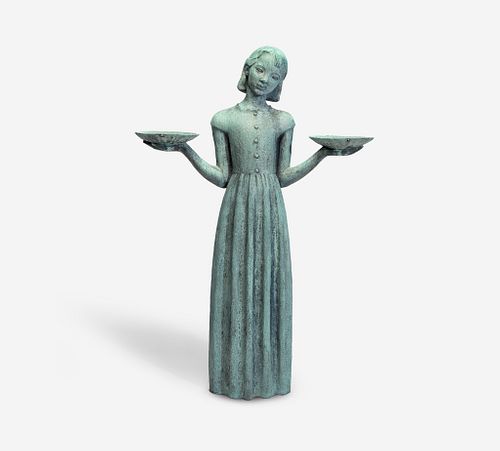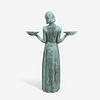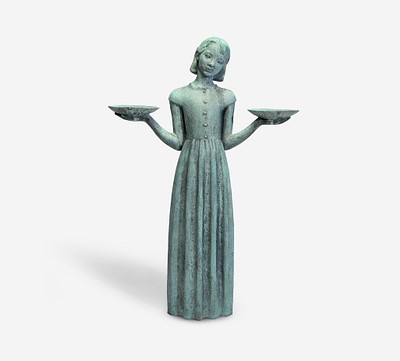Sylvia Shaw Judson (American, 1897-1978) Bird Girl
About Seller
2400 Market St
Philadelphia, PA 19147
United States
Established in 1805, Freeman’s Auction House holds tradition close, with a progressive mind-set towards marketing and promotion, along with access to a team of top experts in the auction business. And now with offices in New England, the Southeast, and on the West Coast, it has never been easier to ...Read more
Two ways to bid:
- Leave a max absentee bid and the platform will bid on your behalf up to your maximum bid during the live auction.
- Bid live during the auction and your bids will be submitted real-time to the auctioneer.
Bid Increments
| Price | Bid Increment |
|---|---|
| $0 | $25 |
| $500 | $50 |
| $1,000 | $100 |
| $2,000 | $200 |
| $3,000 | $250 |
| $5,000 | $500 |
| $10,000 | $1,000 |
| $20,000 | $2,000 |
| $30,000 | $2,500 |
| $50,000 | $5,000 |
| $100,000 | $10,000 |
About Auction
Jun 6, 2021
Freeman’s is pleased to present Sylvia Shaw Judson’s Bird Girl, the highlight of the June 6 auction. In addition to the sculpture, this auction will also feature several notable works by significant American artists, including Daniel Garber, Norman Rockwell, Edward Redfield, and William Harnett. Freeman's info@freemansauction.com
- Lot Description
Sylvia Shaw Judson (American, 1897-1978) Bird Girl
Conceived in 1936, cast in 1938. Number 2 (of 4). With 'ROMAN BRONZE WORKS NY' foundry mark along the rim of the girl's dress verso, bronze with verdigris patina
Height: 50 in. (127cm)Provenance
The Artist.
Acquired directly from the above when exhibited at Dayton Art Institute in April, 1939.
Collection of Mrs. Davidson, Washington, D.C.
By descent in the family.
Private Collection, Reading, Pennsylvania. Private Estate, Reading, Pennsylvania.
Footnote:Exhibited
"Exhibition of Sculpture by Sylvia Shaw Judson," The Art Institute of Chicago, Chicago, Illinois, July 28-October 9, 1938 (as Fountain Figure); and later part of the "Circuit Exhibition," in Milwaukee Art Museum, Milwaukee, Michigan; Indianapolis Museum of Art, Indianapolis, Indiana; Flint Institute of Arts, Flint, Michigan; Dayton Art Institute, Dayton, Ohio; and Zanesville Museum of Art, Zanesville, Ohio, 1938-1939, (traveling exhibition, not included in the last stop).
Literature
Sylvia Shaw Judson, For Gardens and Other Places: The Sculptures of Sylvia Shaw Judson, Henry Regnery Co., Washington D.C., 1967, cover illustration (cast no. 1 illustrated).
John Berendt, Midnight in the Garden of Good and Evil, Random House, New York, cover illustration (cast no. 4 illustrated).
Sandra L. Underwood, The Bird Girl: The Story of a Sculpture by Sylvia Shaw Judson, Schiffer Publishing Ltd., Atglen, 2006, cover illustration (cast no. 4 illustrated throughout, except p. 14, cast no. 1).Note
It is arguably one of the most recognizable sculptures in the history of American Art. Everyone knows her: the silhouette of a slender girl dressed in a full length buttoned dress, holding a pair of shallow bowls in outstretched arms - like the figure of Justice herself. It is Bird Girl, the famed life-size statue of a nine-year old girl forever associated with John Berendt’s 1994 best-seller Midnight in the Garden of Good and Evil, and Clint Eastwood’s subsequent 1997 movie.
The sculpture was conceived in 1936 by Chicago artist Sylvia Shaw Judson, who at the time was mostly known for her Little Gardner, a version of which exists at the White House and the Monument to the Quaker Martyr Mary Dyer at Boston’s State House. It was sculpted in Ragdale, the artist’s family retreat home in Lake Forest, Illinois. Only four bronzes were made from the original plaster cast (one version in lead predating the bronzes also exists, as well as two additional posthumous casts, not considered as originals). The most famous statue was completed last, and bought by the Trosdal family from Savannah, Georgia, who renamed it “Little Wendy” as she presided over the family burial plot in the Bonaventure Cemetery. There, “and although she was quite unlike the other funeral monuments in this place, she settled in and took her duties quite seriously” says Sandra L. Underwood, judging from the girl’s contemplative, gracefully tilted gaze. The statue stood unnoticed in the cemetery until 1993, when Random House hired Savannah-based photographer Jack Leigh (now buried at Bonaventure) to shoot the cover of John Berendt’s new non-fiction book. Leigh found the sculpture on the Trosdal’s burial plot at the end of his second day of research, as dusk was settling in. The magic happened ten hours later in the darkroom, where he gave the photo a crepuscular feel by accentuating the halo around the statue’s head, enveloping it with the perfect mix of light, shadow and darkness. The cover image was an instant success – a true symbol of the Deep South – and Berendt called it "one of the strongest book covers I've ever seen". The book became an all-time bestseller, and soon visitors began to flock to Bonaventure Cemetery to see the sculpture. Due to rising concerns about the increasing number of people visiting the grave site each day, the Trosdal family had it removed from the cemetery and later lent it to the Telfair Museums in Savannah, for public display in their Telfair Academy Building.
Our version of Bird Girl was the second bronze Judson made at the Roman Bronze Works in New York City. It is the twin version of the original bronze sculpture, directly commissioned from the artist by Mr. and Mrs. Edward L. Ryerson as a garden statue for their summer home in Marion, Massachusetts. Because the original sculpture was to be kept in a private collection, the present bronze was specially made for the exhibition circuit, as a promotional tool for Judson to showcase her talent. Alternatively titled Standing Figure, Fountain Figure or Peasant Girl, the sculpture was featured as Girl with Bowls in Judson’s first one-person show at the Art Institute of Chicago between July-October 1938. It later joined a Circuit Exhibition and started to tour across five museums in the Midwest (Milwaukee, Wisconsin; Indianapolis, Indiana; Flint, Michigan; Dayton, Ohio; and Zanesville, Ohio). In April 1939, while on display at the Dayton Art Institute, the director of the Dayton Art Institute received a letter from a certain Mrs. Davidson of Washington D.C, inquiring about the work. At her pressing request, the sculpture was shipped to her house at the end of the show, before its inclusion in the fifth and last leg of its tour in Zanesville. Ultimately, the sculpture was inherited by a daughter of Mrs. Davidson, who took her to her home in Reading, PA - where she has remained until this day.
Historically, Bird Girl was conceived by Judson as a garden sculpture, and our own version was always used as such by its owners, judging from its beautiful verdigris patina.The shallow bowls extended in each of her palms were intended to hold either water or food for the birds. The sculpture could also have been conceived so that it could operate as a fountain, judging from the narrow slots at the front of the bowls which would allow water to slowly spill out. However, there are no records of either sculpture being used as such. Contrary to other sculptors who exhibited widely and through certified galleries across the country, Judson achieved her reputation by herself, solely by making garden sculptures. Her success earned her respect, but not much publicity since gardens were, by essence, private places that few could visit. Judson’s sculptures were also so successful among her patrons that her work, almost without exception, came into a family and remained there without ever appearing on the primary or secondary market, such as the present work.
In order to complete Bird Girl, Judson felt she needed a model, and she indeed found one in nine year-old Lorraine Greenman, who Judson discovered in a dance class in Chicago. The artist was interested in the child because she was well proportioned. The thin, blonde and blue-eyed girl also had a pleasing face with soft features, a tender smile, which Shaw would turn into an anonymous, immortal image of youth. As Sandra Underwood sums it up: “Bird Girl is as Judson hoped she would be, a good sculpture, carefully composed, well made, and well suited for life in a garden. A figure that stands solid and quietly, a strong and simple form. A surface that catches light and invites touch (…) A human presence in a human scale (a child, child-size). And a serene spirit that offers us in this troubled age the tranquility we find too seldom.”
Condition report:For a complete Condition Report, please email Raphaël Chatroux at rchatroux@freemansauction.com. For further questions, please call 215.882.3680.
- Shipping Info
-
No lot may be removed from Freeman’s premises until the buyer has paid in full the purchase price therefor including Buyer’s Premium or has satisfied such terms that Freeman’s, in its sole discretion, shall require. Subject to the foregoing, all Property shall be paid for and removed by the buyer at his/ her expense within ten (10) days of sale and, if not so removed, may be sold by Freeman’s, or sent by Freeman’s to a third-party storage facility, at the sole risk and charge of the buyer(s), and Freeman’s may prohibit the buyer from participating, directly or indirectly, as a bidder or buyer in any future sale or sales. In addition to other remedies available to Freeman’s by law, Freeman’s reserves the right to impose a late charge of 1.5% per month of the total purchase price on any balance remaining ten (10) days after the day of sale. If Property is not removed by the buyer within ten (10) days, a handling charge of 2% of the total purchase price per month from the tenth day after the sale until removal by the buyer shall be payable to Freeman’s by the buyer. Freeman’s will not be responsible for any loss, damage, theft, or otherwise responsible for any goods left in Freeman’s possession after ten (10) days. If the foregoing conditions or any applicable provisions of law are not complied with, in addition to other remedies available to Freeman’s and the Consignor (including without limitation the right to hold the buyer(s) liable for the bid price) Freeman’s, at its option, may either cancel the sale, retaining as liquidated damages all payments made by the buyer(s), or resell the property. In such event, the buyer(s) shall remain liable for any deficiency in the original purchase price and will also be responsible for all costs, including warehousing, the expense of the ultimate sale, and Freeman’s commission at its regular rates together with all related and incidental charges, including legal fees. Payment is a precondition to removal. Payment shall be by cash, certified check or similar bank draft, or any other method approved by Freeman’s. Checks will not be deemed to constitute payment until cleared. Any exceptions must be made upon Freeman’s written approval of credit prior to sale. In addition, a defaulting buyer will be deemed to have granted and assigned to Freeman’s, a continuing security interest of first priority in any property or money of, or owing to such buyer in Freeman’ possession, and Freeman’s may retain and apply such property or money as collateral security for the obligations due to Freeman’s. Freeman’s shall have all of the rights accorded a secured party under the Pennsylvania Uniform Commercial Code.
-
- Buyer's Premium



 EUR
EUR CAD
CAD AUD
AUD GBP
GBP MXN
MXN HKD
HKD CNY
CNY MYR
MYR SEK
SEK SGD
SGD CHF
CHF THB
THB













